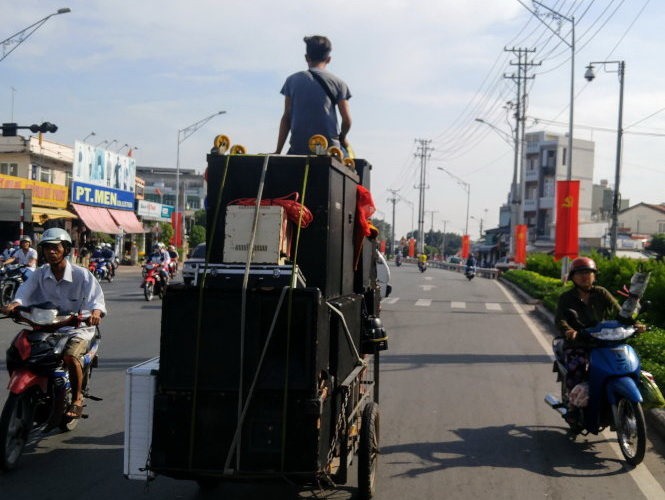 Society
Society

Residents of Mekong Delta provinces such as Bến Tre and Long An have complained about being bombarded with noise over the Tết holiday this year. The Tuổi Trẻ (Youth) newspaper reported that locals suffered from the excessive use of neighbors’ karaoke systems.
 |
| Big speakers for rent transported to customers on a street in Long An Province. – Photo tuoitre.vn |
HÀ NỘI — Residents of Mekong Delta provinces such as Bến Tre and Long An have complained about being bombarded with noise over the Tết holiday this year. The Tuổi Trẻ (Youth) newspaper reported that locals suffered from the excessive use of neighbours’ karaoke systems.
According to the report, rural areas saw increased demand for speakers and microphones during the holiday. Nguyễn Văn Linh, owner of a karaoke-rental shop in Tân An City of Long An Province, noticed a surge in orders in the run up to Tết.
“The rental of a TV, sound system, and five big speakers costs about VNĐ700,000 (US$31). Due to high demand this surged to more than VNĐ1 million (US$45) during Tết. We often ran out of equipment in the holiday period,” he said.
While karaoke lovers were free to turn up the volume and sing to their hearts’ content, neighbours were forced to endure to high levels of noise late into the night.
Nguyễn Văn Hai, from Lợi Bình Nhơn Ward of Tân An City complained “My two neighbours hired karaoke equipment. My family and I had to escape to my wife’s house in Châu Thành District. There we were still tortured by the neighbours’ excessive music. We had no peace during the holiday,” he said.
Tăng Thị Huế in Bình Minh District of Vĩnh Long Province said “I could not bear the irritating noise. I planned to return to my rented house on the seventh day of the New Year but I had to leave two days earlier,” he said.
Sometimes the irritation caused by excessive noise can boil over into violence.
A resident in Tân Phú Ward of Châu Thành District in Bến Tre Province turned his music up, only to find an angry neighbour beating the speakers with a wooden stick. This is only one example where an evening of entertainment descended into a brawl.
Trần Hoàng Liêm, chairman of Tân Phú Ward’s People’s Committee said that local authorities are also fed up of the noise. Many locals have claimed this form of entertainment is reasonable for Tết celebrations. However, long-suffering locals are not satisfied, saying that if authorities cannot address the issue, they will take matters into their own hands.
Ironically, to take revenge on disturbances, neighbours resort to playing their own music at deafening volumes.
Nguyễn Tấn Quốc, an inspector from the Department of Culture, Sports and Tourism of Long An Province said that dealing with noise pollution from karaoke equipment was very difficult, adding that specific punishments were not imposed on any case during the Tết holiday.
“Imposing penalties on noise pollution requires a number of steps. The majority of the localities only issue reminders and raise local awareness,” he said.
A Tuổi Trẻ reader suggested that violation management must be assigned to ward-level authorities instead of the local department of culture and information because the department’s officials do not directly, and regularly monitor the area.
Dr Lý Tùng Hiếu, Culture Faculty of the University of Social Sciences and Humanities under HCM City-based Việt Nam National University said that noise pollution was a long-standing and serious “disease” in residential areas of Việt Nam’s big cities, especially when equipment such as high-capacity speakers could be purchased and rented at low prices.
Lawyer Nguyễn Tấn Thi said that noise violations could be subject to various punishments, ranging from VNĐ1 million up to VNĐ160 million ($7,110).
However, very few violations receive fines. Excessive noise becomes more common during Tết.
Laws were not implemented easily because of a lack of officers, the newspaper reported. Additionally, localities were not equipped with noise measurement devices to determine the levels of noise pollution. — VNS




